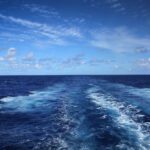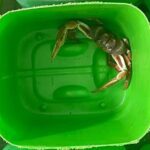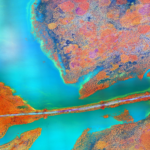In this series, we’re sharing practices of community-engaged research (CER): researchers and community partners working together to advance community goals and science.
Building partnerships with local communities in study of Mekong fish movement
Fish are central to the culture and livelihood of communities along the Mekong River in Cambodia. As is true for many freshwater ecosystems, the Mekong River and the fisheries it supports are impacted by anthropogenic factors.
This photo diary highlights community-engaged research in the Mekong River. Scientists from FISHBIO and the Inland Fisheries Research and Development Institute (IFReDI) are working with local fishers to understand fish migration in the Mekong River using acoustic telemetry. Telemetry relies on sound-emitting tags that are surgically implanted in fish, and movements of these tagged fish are tracked using floating “listening” stations.
The Don Sahong Dam
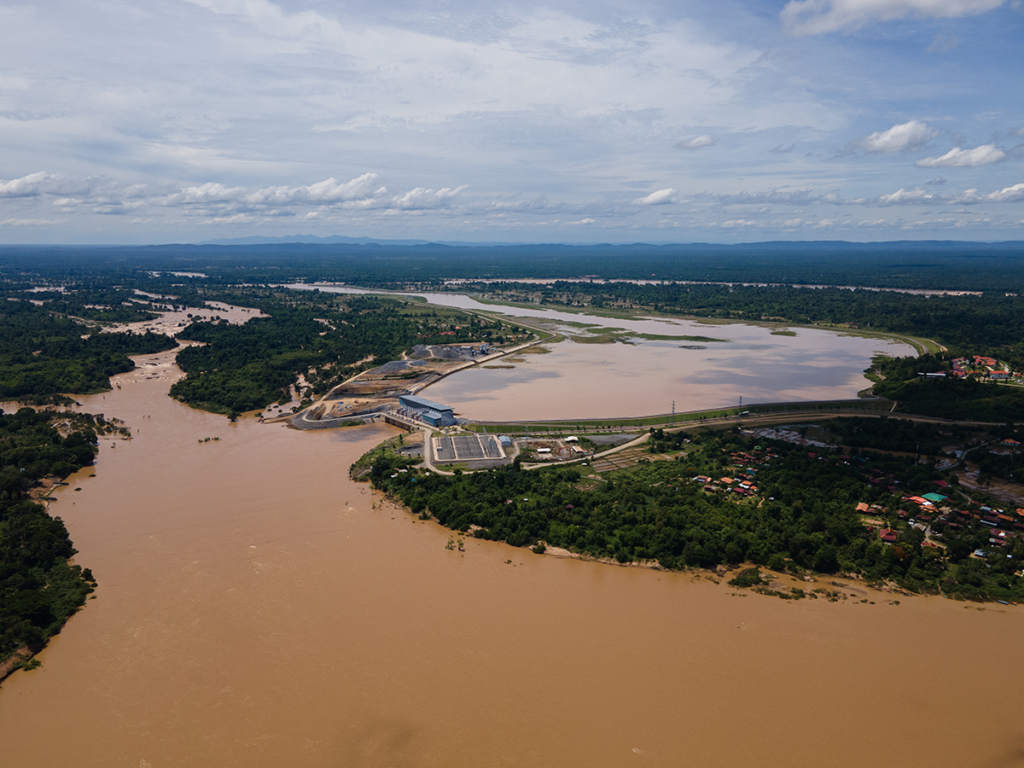 Commissioned in 2020, Don Sahong Dam lies on the border between Cambodia and Lao People’s Democratic Republic (Lao PDR). Dams, overfishing, and climate change are likely causing important impacts on fish movement through the region. The Wonders of the Mekong acoustic telemetry study in Cambodia, as well as a partner study by the Mekong River Commission in Lao PDR, are seeking to learn more about these impacts.
Commissioned in 2020, Don Sahong Dam lies on the border between Cambodia and Lao People’s Democratic Republic (Lao PDR). Dams, overfishing, and climate change are likely causing important impacts on fish movement through the region. The Wonders of the Mekong acoustic telemetry study in Cambodia, as well as a partner study by the Mekong River Commission in Lao PDR, are seeking to learn more about these impacts.
Data on fish movement is the golden ticket
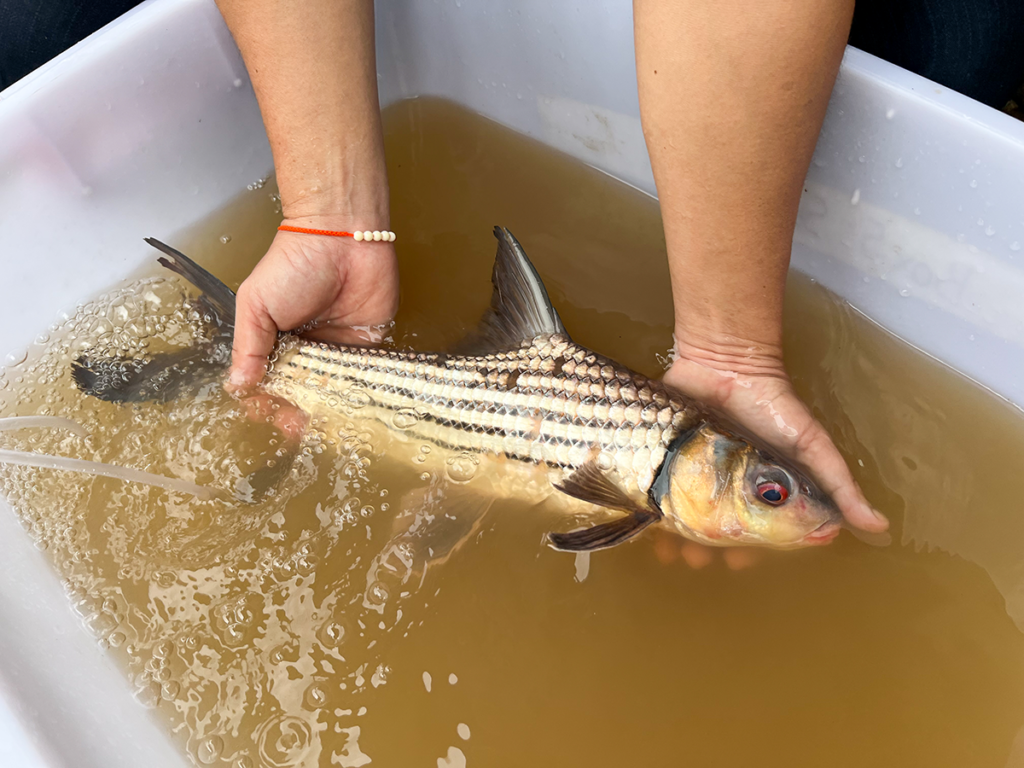 A Critically Endangered Jullien’s Golden Carp (Probarbus jullieni) that was captured by local fishers from the Koh Preah community and provided to the study for tagging and release. Endangered and economically important migratory fish species are the focus of this acoustic telemetry project in the Mekong. Knowing where and when fish migrate will help inform future conservation efforts.
A Critically Endangered Jullien’s Golden Carp (Probarbus jullieni) that was captured by local fishers from the Koh Preah community and provided to the study for tagging and release. Endangered and economically important migratory fish species are the focus of this acoustic telemetry project in the Mekong. Knowing where and when fish migrate will help inform future conservation efforts.
Deploying a receiver
 FISHBIO and IFReDI staff deploy a floating barrel system in the Mekong River. These floating barrels, which were designed and constructed with the help of local fishing communities, provide a platform for mounting acoustic receivers. The network of receivers deployed throughout the watershed will monitor the movement of tagged fish as they move throughout the Mekong and its key tributaries.
FISHBIO and IFReDI staff deploy a floating barrel system in the Mekong River. These floating barrels, which were designed and constructed with the help of local fishing communities, provide a platform for mounting acoustic receivers. The network of receivers deployed throughout the watershed will monitor the movement of tagged fish as they move throughout the Mekong and its key tributaries.
Team discussion
 One of the main project partners for this project is Young Eco Ambassadors (YEA), a Cambodian organization that has led the charge on community outreach and engagement. YEA and IFReDI staff discuss receiver deployment. Partnerships between FISHBIO, YEA, IFReDI, and local communities have allowed for the deployment and maintenance of a country-wide acoustic receiver network.
One of the main project partners for this project is Young Eco Ambassadors (YEA), a Cambodian organization that has led the charge on community outreach and engagement. YEA and IFReDI staff discuss receiver deployment. Partnerships between FISHBIO, YEA, IFReDI, and local communities have allowed for the deployment and maintenance of a country-wide acoustic receiver network.
Downstream data download
 YEA and IFReDI staff work with local community members to download data from an acoustic receiver just downstream of the border with Lao PDR, where transboundary movement of fish has recently been detected. A network of community members provide project staff with updates on the status of the floating receivers, and help to conduct repairs and downloads as needed.
YEA and IFReDI staff work with local community members to download data from an acoustic receiver just downstream of the border with Lao PDR, where transboundary movement of fish has recently been detected. A network of community members provide project staff with updates on the status of the floating receivers, and help to conduct repairs and downloads as needed.
Not your average fish tank

A hand-made holding tank for fish constructed adjacent to a mobile surgery station during a fish tagging trip to Koh Preah. The sourcing of healthy fish is essential for the movement study, and a network of local fishers was organized to update project staff on when and where suitable fish are being caught.
Tagging a freshwater giant
 The first fish that was tagged for this study was also the largest. FISHBIO, YEA, and IFReDI staff were deploying the acoustic receiver network in Stung Treng province when they were notified by local fishers that a Giant Freshwater Stingray (Urogymnus polylepis) had been captured. With the help of local community members, they implanted this fish with an acoustic tag, and have been tracking its movement with the network. This individual has been declared the largest freshwater fish on record, and its tag has been detected several times over the past five months.
The first fish that was tagged for this study was also the largest. FISHBIO, YEA, and IFReDI staff were deploying the acoustic receiver network in Stung Treng province when they were notified by local fishers that a Giant Freshwater Stingray (Urogymnus polylepis) had been captured. With the help of local community members, they implanted this fish with an acoustic tag, and have been tracking its movement with the network. This individual has been declared the largest freshwater fish on record, and its tag has been detected several times over the past five months.
Local fisher, local fish
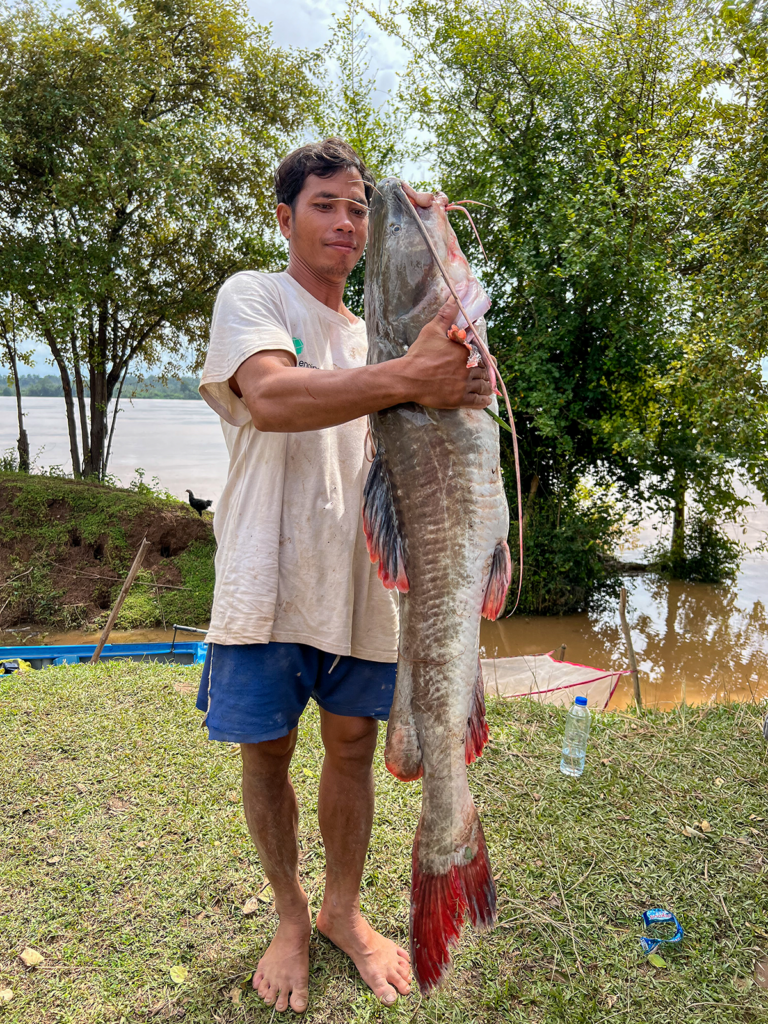 A fisher in Koh Preah holding a 14-kilogram Asian Redtail Catfish (Hemibagrus wyckioides). Finding fish in good enough condition to be tagged has been challenging. Commonly used gears like gill nets often leave fish injured or dead, but fishers who use gears that have less impact on fish health – such as bamboo traps – have provided the team with healthy individuals for surgery.
A fisher in Koh Preah holding a 14-kilogram Asian Redtail Catfish (Hemibagrus wyckioides). Finding fish in good enough condition to be tagged has been challenging. Commonly used gears like gill nets often leave fish injured or dead, but fishers who use gears that have less impact on fish health – such as bamboo traps – have provided the team with healthy individuals for surgery.
Measuring from tip to tail
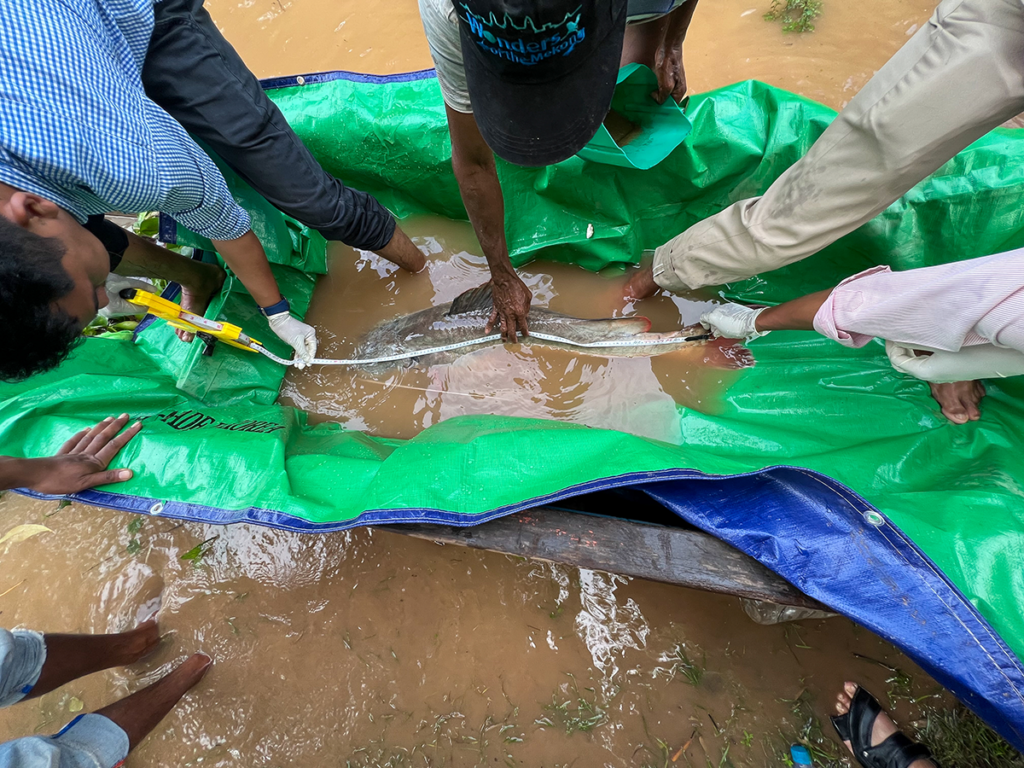 IFReDI staff and local fishers measure the length of an Asian Redtail Catfish (Hemibagrus wyckioides) prior to implanting an acoustic tag. Careful records are kept on the length and weight of each tagged fish, data which may be useful for estimating growth if individuals are recaptured.
IFReDI staff and local fishers measure the length of an Asian Redtail Catfish (Hemibagrus wyckioides) prior to implanting an acoustic tag. Careful records are kept on the length and weight of each tagged fish, data which may be useful for estimating growth if individuals are recaptured.
River-side surgery
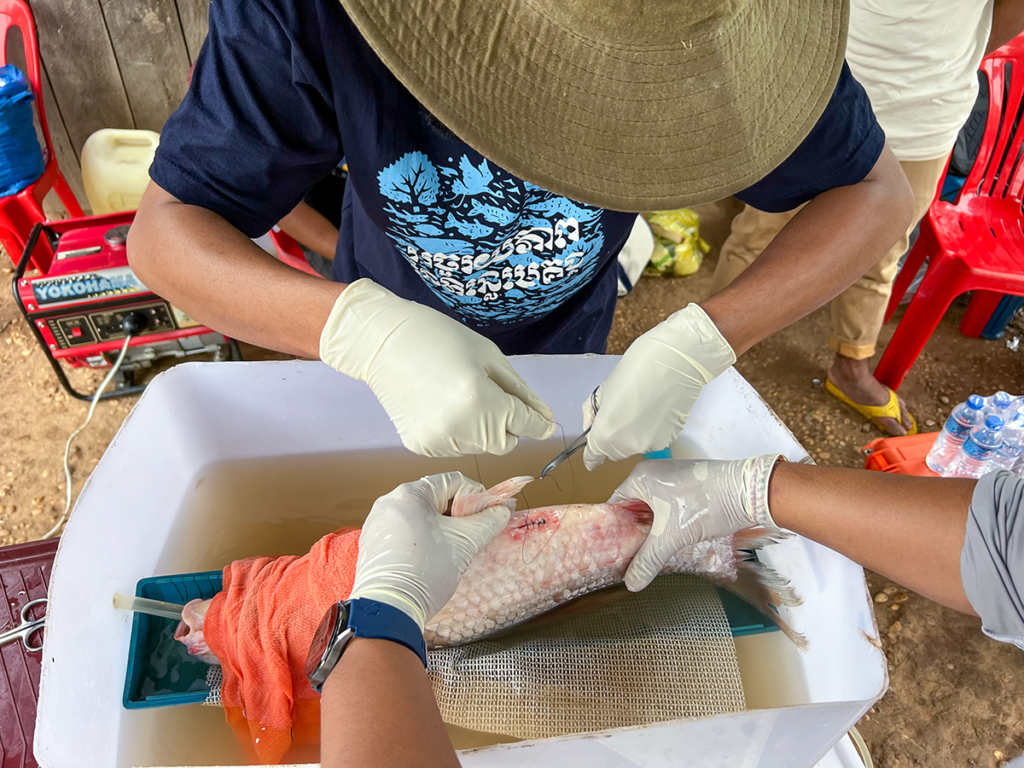 An IFReDI scientist conducts an acoustic tag implantation surgery. The field team travels throughout the study region, which has required the development of a mobile surgery setup. Local communities have helped to establish field surgery stations and associated fish holding tanks.
An IFReDI scientist conducts an acoustic tag implantation surgery. The field team travels throughout the study region, which has required the development of a mobile surgery setup. Local communities have helped to establish field surgery stations and associated fish holding tanks.
Acoustic telemetry team in the Mekong
 YEA, FISHBIO, and IFReDI staff with local community members in Koh Preah. Outreach and engagement of local communities has helped to build a broad network of local support ranging from the Cambodian border with Lao PDR all the way to Kampong Cham, 300 kilometers downstream.
YEA, FISHBIO, and IFReDI staff with local community members in Koh Preah. Outreach and engagement of local communities has helped to build a broad network of local support ranging from the Cambodian border with Lao PDR all the way to Kampong Cham, 300 kilometers downstream.
All in-text images: © FISHBIO via Flickr, used with permission.
Banner image: © FISHBIO via Flickr, used with permission
Banner caption: Deploying acoustic receiver | In an effort funded by USAID’s Wonders of the Mekong Project, scientists from FISHBIO and the Inland Fisheries Research and Development Institute (IFReDI) of the Cambodian Fisheries Administration worked with local community members to install a floating acoustic receiver platform in the Mekong River. Fishing communities throughout the Mekong and key tributaries helped to construct and establish the receiver network, and are now playing a vital role in maintaining the equipment.


